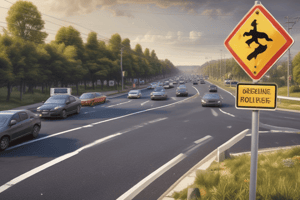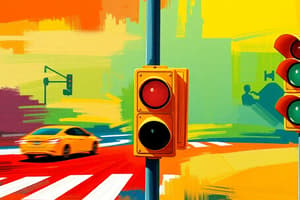Podcast
Questions and Answers
What are traffic control devices designed to do?
What are traffic control devices designed to do?
- Tell drivers where they are going (correct)
- Restrict all vehicle movement
- Create traffic jams
- Ensure highway safety (correct)
What color and shape are most warning signs?
What color and shape are most warning signs?
Diamond shape and yellow/black
Give a few examples of regulatory signs.
Give a few examples of regulatory signs.
Stop sign, yield sign, do not enter, one-way
What are warning signs designed to convey?
What are warning signs designed to convey?
What are guide signs used for?
What are guide signs used for?
What shapes and colors are construction zone signs?
What shapes and colors are construction zone signs?
What do white or yellow broken lines indicate?
What do white or yellow broken lines indicate?
What are white lines used for?
What are white lines used for?
What does a red X in a reversible lane signify?
What does a red X in a reversible lane signify?
What is the purpose of a shared left-turn lane?
What is the purpose of a shared left-turn lane?
What are examples of traffic control devices?
What are examples of traffic control devices?
What is the main purpose of traffic control devices?
What is the main purpose of traffic control devices?
Traffic signs only warn drivers about hazards.
Traffic signs only warn drivers about hazards.
What are the three types of traffic signs?
What are the three types of traffic signs?
The color _____ indicates a stop.
The color _____ indicates a stop.
The shape of a stop sign is an _____ .
The shape of a stop sign is an _____ .
What does a flashing yellow light indicate?
What does a flashing yellow light indicate?
What do yellow lines signify?
What do yellow lines signify?
What do white arrows on the roadway indicate?
What do white arrows on the roadway indicate?
Match the following colors with their traffic sign meanings:
Match the following colors with their traffic sign meanings:
What does the diamond shape in traffic signs usually indicate?
What does the diamond shape in traffic signs usually indicate?
What is the meaning of a steady red traffic light?
What is the meaning of a steady red traffic light?
Drivers must yield to pedestrians only at crosswalks.
Drivers must yield to pedestrians only at crosswalks.
Flashcards are hidden until you start studying
Study Notes
Traffic Control Devices
- Common devices include barricades, vertical signs, concrete barriers, drums, and cones for guiding drivers through work zones.
- Drivers must maintain lane position and obey speed limits when near these devices; lane changes should only occur once clear of the zone.
Purpose of Traffic Control Devices
- Designed to enhance highway safety and ensure orderly traffic movement for both motorized and nonmotorized users.
- Provide critical information about location, direction, laws, hazards, and roadway conditions.
Communication Modes
- Utilize color, shape, words, symbols, and placement to convey messages and guide driver behavior consistently.
Types of Traffic Signs
- Regulatory signs: Indicate traffic laws to be followed.
- Warning signs: Alert drivers to potential dangers ahead.
- Guide/informational signs: Provide directional information.
Traffic Signs
- Help communicate traffic rules, alert to hazards, and indicate locations of services.
- Specific sizes, shapes, and colors enhance visibility from a distance.
Color Coding of Signs
- Red: Indicates prohibitive actions or stop.
- Black: Used for regulatory and route markers.
- Blue: Relates to motorist services.
- White: Seen on regulatory signs.
- Green: Provides guidance and directional information.
- Brown: Indicates recreational and scenic area information.
- Yellow: Signifies general warnings or caution.
- Orange: Used for construction and maintenance alerts.
- Fluorescent pink: Typically indicates incident management activity.
Shapes of Traffic Signs
- Octagon: Represents a stop sign.
- Triangle: Indicates yield.
- Vertical Rectangle: Denotes regulatory messages.
- Horizontal Rectangle: Used for guidance.
- Diamond: Warns of potential hazards.
- Round: Used for railroad advance warnings.
- Pentagon: Marks school zones and crossings.
- Crossbuck: Indicates a railroad crossing.
- Pennant: Signifies no-passing zones.
Regulatory Signs
- Inform drivers of laws regarding speed and traffic movements; characterized by a rectangular shape and specific color patterns (red/white, white/black).
Warning Signs
- Indicate possible dangers on the road ahead; often diamond-shaped with a yellow/black pattern, some may be fluorescent optic yellow for enhanced visibility in school zones.
Traffic Lights and Their Meanings
- Steady Red: Drivers must stop and remain stopped until the light changes.
- Steady Yellow: Signals that the light will soon turn red; drivers should prepare to stop unless too close to safely do so.
- Steady Green: Indicates that drivers may proceed through the intersection if it is safe.
- Flashing Red: Functions like a stop sign; drivers must stop and yield before proceeding.
- Flashing Yellow: Warns drivers to slow down and proceed with caution.
- Arrows:
- Red Arrow: Prohibits movement in the direction of the arrow.
- Yellow Arrow: Signals a pending change to red; prepare to stop.
- Green Arrow: Permits safe turning in the indicated direction if the intersection is clear.
Pavement Markings
- Yellow lines: Separate two-way traffic; solid lines indicate no passing, broken lines allow passing.
- White lines: Separate lanes of traffic in the same direction; solid lines discourage changes near intersections, while broken lines indicate lane changing is permitted.
- Shared left-turn lanes: Middle lanes for turning left from either direction; marked with solid and broken yellow lines.
Reserved or Restricted Lanes
- Specific lanes designated for special vehicles, clearly marked with appropriate signage and symbols.
Incident Signs
- Temporary signs that inform drivers of upcoming stops or road closures due to unforeseen incidents, usually in fluorescent pink.
Additional Notes
- Drivers must yield to pedestrians at all times, regardless of crosswalk presence.
- Special caution should be exercised in areas marked for school zones, railroad crossings, and construction.
Studying That Suits You
Use AI to generate personalized quizzes and flashcards to suit your learning preferences.





